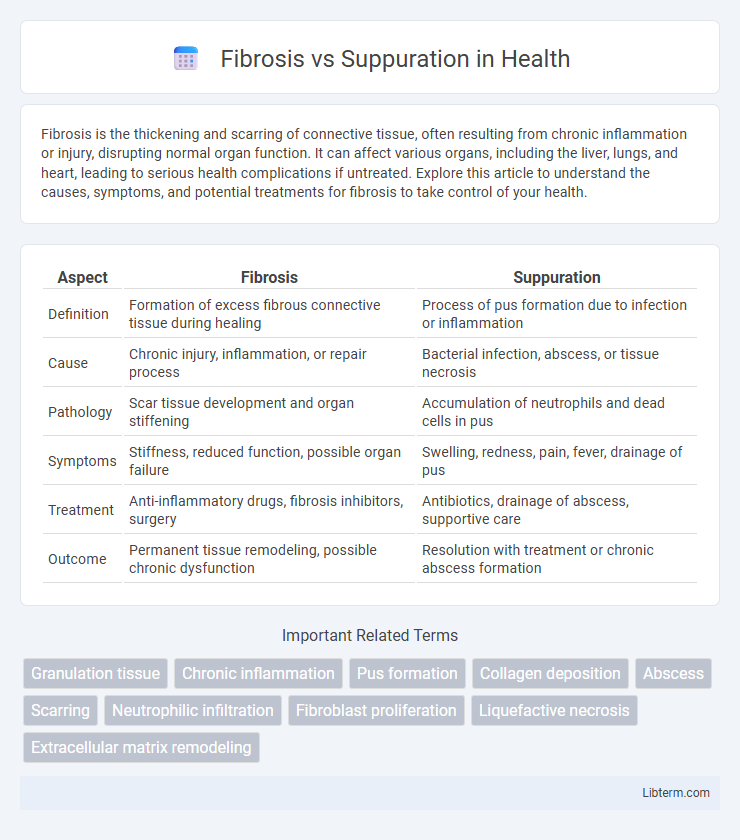Fibrosis is the thickening and scarring of connective tissue, often resulting from chronic inflammation or injury, disrupting normal organ function. It can affect various organs, including the liver, lungs, and heart, leading to serious health complications if untreated. Explore this article to understand the causes, symptoms, and potential treatments for fibrosis to take control of your health.
Table of Comparison
| Aspect | Fibrosis | Suppuration |
|---|---|---|
| Definition | Formation of excess fibrous connective tissue during healing | Process of pus formation due to infection or inflammation |
| Cause | Chronic injury, inflammation, or repair process | Bacterial infection, abscess, or tissue necrosis |
| Pathology | Scar tissue development and organ stiffening | Accumulation of neutrophils and dead cells in pus |
| Symptoms | Stiffness, reduced function, possible organ failure | Swelling, redness, pain, fever, drainage of pus |
| Treatment | Anti-inflammatory drugs, fibrosis inhibitors, surgery | Antibiotics, drainage of abscess, supportive care |
| Outcome | Permanent tissue remodeling, possible chronic dysfunction | Resolution with treatment or chronic abscess formation |
Understanding Fibrosis and Suppuration
Fibrosis is the process of excessive connective tissue formation during healing, leading to scar tissue development that can impair organ function. Suppuration involves the accumulation of pus due to bacterial infection, characterized by the presence of dead neutrophils, tissue debris, and bacteria. Understanding the distinct pathological mechanisms and outcomes of fibrosis and suppuration is crucial for effective diagnosis and treatment in clinical settings.
Key Differences Between Fibrosis and Suppuration
Fibrosis is the thickening and scarring of connective tissue due to chronic inflammation, characterized by collagen deposition and tissue repair, while suppuration involves the accumulation of pus from neutrophil infiltration during acute bacterial infection. Fibrotic tissue is firm and non-fluid, leading to organ stiffness and dysfunction, whereas suppuration results in abscess formation with localized liquid pus and accompanied pain. The main difference lies in fibrosis being a healing response with tissue remodeling, whereas suppuration is an active infectious process marked by purulent inflammation.
Causes and Risk Factors
Fibrosis results from chronic inflammation or tissue injury causing excessive collagen deposition and scar tissue formation, commonly triggered by conditions like chronic infections, autoimmune diseases, or persistent chemical exposure. Suppuration arises from acute bacterial infections leading to pus accumulation, often caused by pathogens such as Staphylococcus aureus, poor wound hygiene, or immune system compromise. Risk factors for fibrosis include prolonged inflammation, repeated tissue damage, and genetic predisposition, while suppuration risk factors involve localized tissue infection, compromised immunity, and insertion of foreign bodies.
Pathophysiology: How Fibrosis Develops
Fibrosis develops as a result of chronic inflammation leading to excessive extracellular matrix deposition by activated fibroblasts and myofibroblasts, primarily driven by cytokines such as transforming growth factor-beta (TGF-b). Persistent tissue injury triggers the recruitment of immune cells, release of pro-fibrotic mediators, and alteration of normal tissue repair mechanisms, culminating in scar tissue formation and organ dysfunction. Unlike suppuration, which involves acute pus formation from neutrophil-driven infection, fibrosis represents a maladaptive chronic healing response causing tissue stiffening and loss of function.
Pathophysiology: The Process of Suppuration
Suppuration is the process of pus formation due to tissue infection and necrosis, characterized by the accumulation of dead neutrophils, bacteria, and cellular debris within an abscess. This inflammatory response triggers the release of proteolytic enzymes and cytokines, leading to localized tissue destruction and an acute immune reaction. In contrast, fibrosis involves the chronic activation of fibroblasts and excessive collagen deposition, resulting in tissue scarring rather than pus accumulation.
Clinical Manifestations
Fibrosis presents clinically with firm, indurated tissue and progressive loss of elasticity leading to organ dysfunction, often associated with chronic inflammatory conditions such as liver cirrhosis and pulmonary fibrosis. Suppuration manifests as localized pain, redness, swelling, and purulent discharge in abscess formation, often accompanied by systemic signs like fever and leukocytosis due to acute infection. Differentiating these conditions relies on the presence of fibrotic scarring versus purulent inflammation evident in clinical examination and imaging.
Diagnostic Approaches
Diagnostic approaches for fibrosis primarily involve imaging techniques such as ultrasound elastography, MRI, and CT scans to detect tissue stiffness and scarring, alongside histopathological examination of biopsy samples. Suppuration diagnosis focuses on identifying localized infections through clinical examination, ultrasound imaging to detect abscess formation, and microbiological culture or Gram staining of pus samples to identify causative organisms. Laboratory tests including complete blood count and inflammatory markers like C-reactive protein further aid in differentiating between fibrotic tissue and active suppurative infection.
Treatment Strategies
Fibrosis treatment focuses on reducing collagen deposition and promoting tissue remodeling using antifibrotic agents such as pirfenidone and nintedanib, alongside physical therapy to restore function. Suppuration requires prompt drainage of abscesses combined with targeted antibiotic therapy to eradicate infection and prevent systemic spread. Early intervention tailored to the underlying pathophysiology optimizes patient outcomes in both conditions.
Prognosis and Complications
Fibrosis often leads to tissue stiffening and functional impairment, with a relatively stable prognosis if progression is controlled, but can result in chronic organ dysfunction or failure. Suppuration, characterized by pus formation due to infection, typically has an acute onset and requires prompt drainage and antibiotic therapy to prevent systemic complications like sepsis or abscess formation. Prognostic outcomes differ significantly, with fibrosis posing long-term complications, while suppuration presents immediate risks that can escalate without timely intervention.
Conclusion: Fibrosis vs Suppuration in Clinical Practice
Fibrosis results from chronic inflammation leading to excessive collagen deposition and tissue scarring, whereas suppuration involves acute infection characterized by pus formation due to neutrophil accumulation. In clinical practice, distinguishing fibrosis from suppuration is crucial as fibrosis indicates a reparative or chronic process requiring anti-fibrotic or immunomodulatory therapy, while suppuration demands prompt antimicrobial treatment and drainage. Accurate diagnosis through imaging and histopathology ensures appropriate management, reducing complications such as chronic tissue damage or ongoing infection.
Fibrosis Infographic

 libterm.com
libterm.com